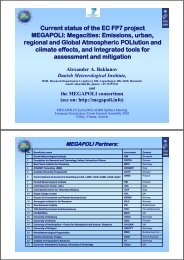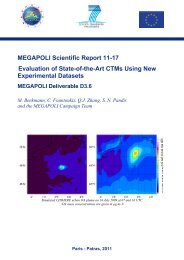D E S C R I P T I O N O F W O R K - MEGAPOLI - Dmi
D E S C R I P T I O N O F W O R K - MEGAPOLI - Dmi
D E S C R I P T I O N O F W O R K - MEGAPOLI - Dmi
Create successful ePaper yourself
Turn your PDF publications into a flip-book with our unique Google optimized e-Paper software.
<strong>MEGAPOLI</strong> 212520<br />
CAIR4HEALTH and ENVIRISK. Health risks will be calculated using concentration-response- and<br />
exposure-response relationships developed and recommended in these projects, different health<br />
endpoints can then be aggregated using DALY’s (disability adjusted life years). Climate change<br />
damage is assessed using results from the FUND model (developed by R. Tol, University of<br />
Hamburg) and by analysing studies on climate change impacts including the IPCC report and<br />
DEFRA studies. Damage to ecosystems from acidification and eutrophication is assessed with a<br />
method developed in the NEEDS project using ‘potentially disappearing fractions’ of species as<br />
damage indicators.<br />
To be able to compare the different damage categories with each other and with costs of measures,<br />
the damage indicators should be converted into a common unit; here monetary units are chosen<br />
using contingent valuation, which measures the preference of the population, e.g. by surveys about<br />
the willingness to pay to avoid a (small) risk, as means to allocate monetary values to risks and<br />
damages. Again, results of the above mentioned projects, especially NEEDS, are used. Using the<br />
monetized results, cost-benefit analyses can be carried out (for short and medium term measures,<br />
for long term measures benefits are calculated). To be able to generate these results efficiently, a<br />
computer tool is developed (task 3 of this WP).<br />
A first analysis will ask about the development of impacts from megacities, for the case that no<br />
additional measures are implemented. For that, a baseline scenario will be developed together with<br />
WP1, assuming a trend development of activities and emission factors that takes into account<br />
current legislation and legislation in the pipeline. Available policy options (possibilities for<br />
implementing instruments by the policy makers to accomplish their goals), which could be<br />
implemented in addition to those of the baseline scenario, will be systematically collected.<br />
Assumptions will have to be made about how the operators and users of emission sources react to<br />
these options, i.e., which abatement and mitigation measures they will implement. Both technical<br />
measures (changing emissions factors, e.g., an additional filter) and non-technical measures (which<br />
change the decisions and the behaviour of users of emission sources, e.g., by implementing a<br />
charge on emissions) will be addressed. The whole analysis will be carried out for the 1st level<br />
cities and agglomerations: Paris, London, Rhine-Ruhr and the Po Valley. In addition, Mexico-City<br />
will also be analysed as an example for cities in developing countries with quite different<br />
development prospects and features. The definition and the assessment of the scenarios are carried<br />
out in close cooperation and discussion with the main stakeholders, especially the administration of<br />
the megacities that are analysed, and the EC; this is achieved and planned in task 2 of the WP.<br />
A major innovation of this project is that it strives for a full integrated assessment of megacities.<br />
Policy options and mitigation measures generally influence the emission of more than one pollutant,<br />
thus for assessing such measures all effected impacts have to be taken into account. In addition,<br />
especially the relationship between climate change and air pollution is important, but not yet fully<br />
analysed. Thus the integration occurs:<br />
- across impacts, especially climate change impacts and air pollution impacts, including health risks<br />
and ecosystem damage;<br />
- across pollutants and emission sources, e.g. transport, energy conversion, industry, households,<br />
waste, agriculture, natural and biogenic processes; PM10, PM2.5, ozone, acid substances, nutrients,<br />
greenhouse gases, and others;<br />
- across scales: local, urban, regional, global; short, medium and long term.<br />
The assessment of policy and mitigation options will be based on the simultaneous assessment of all<br />
relevant changes in damages and risks caused by the option (and not on the potential, e.g., with<br />
regard to the reduction of a single pollutant). The estimation of health, ecosystem and climate<br />
change impacts will be based on the current state of knowledge as currently analysed in running EC<br />
26




